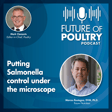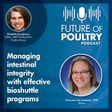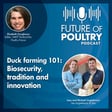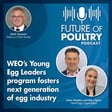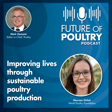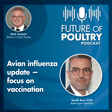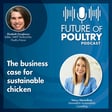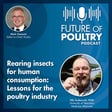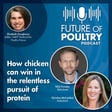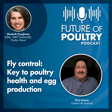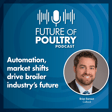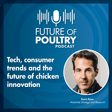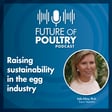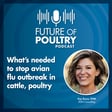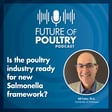Become a Creator today!Start creating today - Share your story with the world!
Start for free
00:00:00
00:00:01

Training poultry science students how to use artificial intelligence
Andrew "Andy" Parks Benson, Ph.D., associate professor, poultry science, University of Georgia, details how he has utilized artificial intelligence to significantly reduce the amount of time it takes him to create case studies for his poultry science classes. He also trains students on using artificial intelligence to successfully complete tasks. Recorded at the 2024 Poultry Science Association Meeting.
Transcript
Introduction and Setup
00:00:00
Speaker
Hello and welcome to the Future of Poultry podcast series. Hi, my name is Terence O'Keefe. I'm the content director for Watt Global Media. And this is another episode of the Future of Poultry podcast. We're live here at the Poultry Science Association annual meeting in Louisville, Kentucky.
AI in Class Materials
00:00:29
Speaker
And with me is Dr. Drew Benson from the University of Georgia Poultry Science Department. And he's presented here on, you know, some new techniques he's using in his Poultry Science classes and found it kind of an interesting use of artificial intelligence.
00:00:50
Speaker
He's using that to help create some of his class materials, but then also the students are using artificial intelligence to complete some of their projects. So, Dr. Benson, can you tell me, how did you get started on this?
Transition to Active Learning
00:01:05
Speaker
Perfect. Well, first off, it was great to be here. So, I knew there was this huge emerging technology that was occurring before us, right? At the same time, I was,
00:01:20
Speaker
making a transition from a traditional, the active teaching environment to an active learning environment. And one of the problems with active learning environment, especially in the culture sciences and animal sciences, is there's not a lot of material you can pull from for that out-of-class content delivery so that when you come into class, you can work on problem sets. And on that matter, there's not a lot of case studies of problem sets.
00:01:46
Speaker
Did you lose? Oh, there was a big burden on that font. So I started playing with, in this case, Chatsy BK. I think it was three at that point. And it increased my efficiency in creating those afterclives tremendously. And I came, I became aware, you know, writing an effective case study now could take me a morning, whereas before I would struggle getting one
00:02:14
Speaker
that I was ready to introduce my students who would take me, you know, a week and a half. And so if I came way more effective, and then I really started getting, what is this being for my students?
AI's Impact on Work Productivity
00:02:28
Speaker
And I started looking into, you know, perspectives of how
00:02:33
Speaker
of AI and large language models are going to change the future of work. And I came to the realization that students really need to be properly introduced to this technology because of how it's going to impact the rest of their lives. I've seen studies where, you know, one quote is that the team engine increased order productivity by a coverage of 20%, and that was revolutionary. And that was the Industrial Revolution, and it changed more.
00:03:03
Speaker
Now we're looking at gains in productivity at the low end of 20% up to 80% of employees across all kinds of different fields and that involve different skill sets that come with using chat TBT. So I knew it was very powerful. Students need to be introduced to it to take advantage and leverage that power. The first thing I did,
00:03:28
Speaker
was create some custom bots.
Custom AI Bots in Poultry
00:03:31
Speaker
So it has some custom GPTs where you can go into the GPT store, you can create your own little chat GPT, and you essentially, it's very user-friendly and intuitive, you direct it of how it should respond, what kind of knowledge base it has, what its attitude is, right down to the kind of jargon it uses. And so I created different bots to represent different
00:03:58
Speaker
perspectives of stakeholders in the vertical integrated model. Because we're always trying to get my students to understand why we do the things we do. And a lot of these decisions come from anticipating or getting perspectives of those stakeholders, which are all different. And so a farmer's perspective is going to be different than an animal rights activist. A consumer's perspective is going to be different than a CEO's perspective. And so having students
00:04:29
Speaker
kind of go over advantages and disadvantages that these stakeholders may perceive with critical integration was kind of the first exercise that brought it up.
00:04:40
Speaker
And I did a really good job of at least getting students to appreciate this technology can be used more than just a glorified Google search engine. I can create, you know, different perspectives. I can create interviews. There's different things that I can do with this technology beyond just probably what they were using it before is an advanced search code.
00:05:05
Speaker
With that also came their ability to start to incorporate others' perspectives in their answers. And that would carry over, it was at the point, at that point it was unintentional. It's exciting to carry over. But that would carry over even into discussion questions that seemingly weren't related to, let's say, the vertical integration. So when we talk about muscle myopathies, now it has students that would come in and kind of give,
00:05:35
Speaker
some kind of perception of how consumers are, you know, what consumers' opinions are concerning muscle myopetes and then how animal rights perceive it and how farmers perceive it. And they were very, they weren't always 100%, but at least it got them into the mindset of incorporating different people's perspectives in decision making. So there's a lot of little skill sets embedded in that paid off that I wasn't aware of.
Personalized AI for Engagement
00:06:05
Speaker
I also wanted to make sure that they just take advantage of using the tool in the best way possible, and that comes with kind of prompt design. And so, give a very brief introduction into how they can properly prompt the GPT to get it to act as they would like to get, you know, outputs that they can work with.
00:06:30
Speaker
And so I had them create their own personal tutor for the course. And so with doing that, you know, you can upload into its chat GBT your course content and it's only really going to pull mostly from that course content. But I wanted to make it fun for them so that they'll come back and reinforce. And so I encourage them to give their little thoughts, personalities. You know, some of them, they were Southern. One of them had it as a
00:06:59
Speaker
I don't remember how they worded it, but it was kind of a snazzy British professor. But what that did is it showed them another capability of this, and hopefully it made reinforcing content and expertise a little more entertaining, and therefore they would engage with it more. So those are some tools that I've used it for. There are some downfalls, but right now my hope is
00:07:29
Speaker
increasing their ability of leveraging this technology to become better managers, better workers, better scientists. And I also hope that through this exposure with it, they're more powerful with it and better realizing its limitations
00:07:57
Speaker
and staying on top of the possibilities.
Case Studies and Real-world Issues
00:08:03
Speaker
Now, when I took some business school classes, you know, MBA courses, they were all focused on case studies and whether as a team or as an individual, you were presented with a problem, a certain amount of information and that it was up to you to come to a solution. So, I understand those like from finance class it would be, well,
00:08:31
Speaker
So, but for an introductory poultry science class, can you describe to us, like, what would a case study entail? What would it be about? Okay. So, for example, one case study that we'll do in the introductory course is looking at what I call the big switch. So, moving from conventional case hands to case free hands and what all goes into that. So, the way that case study is built out is it references back to the study.
00:09:01
Speaker
where they looked at the efficiency, the impact on the environment, the impact on workers, a lot of variables were, a lot of areas were looked at between the two different systems. And so that kind of gives them the information. And then you prompt them from that with specific questions of, okay, what needs to be changed.
00:09:26
Speaker
What are the potential risks of making this switch? What are the driving factors behind this switch? What are some possible management changes that have to occur in which switching occurs has been reared in cages for 50 years to now where they're cage free? And so they have to go through all that and, you know, use their knowledge or expertise to solve these problems or come up with logical explanations for those
00:09:58
Speaker
What's happened with CHEDGBT is I can put a lot of these case studies that I have written in the past, put it in and kind of prompt the CHEDGBT to say, okay, I also want the students to appreciate, you know, maybe different perspectives with those thoughts. I want that incorporated into this case study. And what will happen is CHEDGBT will incorporate prompts or questions into the case study that then,
00:10:28
Speaker
guide the students into taking all of those different perspectives. So the way I look at it is it's a coworker. It's happy to please you, but know that you have to come into the realization that it's there to please you. So sometimes the information is giving you is what you want to hear and not necessarily factual, which is another thing that I'm kind of glad at this point.
00:10:55
Speaker
These are getting a lot better, but I'm glad at this point that they're not perfect, because now most students are a little more cynical of those outlets, and they critically analyze those outlets, and actively look for them to find errors in those outlets when it comes to the content or coverage. And the good thing with poultry is you won't get a lot, because essentially what the chance EPD is doing is just taking words and putting the next logical word that would fit that to that sequence.
00:11:25
Speaker
And it's great for the whole internet. And on the internet, we all know constantly in our classes, we're fighting this information. So the same, this information that is prevalent on the web is going to be the same information that you'll often get in some of these outputs that just you need to ask. So I kind of like that it's still not perfect. I think it's not being perfect is great for getting students to engage in critical analysis.
00:11:54
Speaker
And then, again, hopefully staying on top of where this technology is and using it to their best advantage. Well, definitely, once they enter the industry, they're going to have to answer those same questions that people have where they've been given the wrong answer time and time again. Like, why are we giving hormones to chickens so they'll grow faster? And things like that. And unfortunately, that misappropriation
00:12:23
Speaker
doesn't go away, you know, we can correct people, but still, yeah, they're gonna have to deal with that in the working world. And from what you described, it's kind of an interesting, you know, this, okay, you've got a farm, and should you convert from cages to cage free for layers is the real world type of question that, you know, egg producers in the United States are having to deal with right now in
00:12:52
Speaker
It's fascinating to me when I'm going and talk to people because it depends on what state you're in, you know, who your current customer base is, and in some cases, can you get financing to, you know, to convert, even if you want to convert, can you get the money? So it's a nice situation where you've got a whole bunch of variables in there, and you also have the whole aspect of,
00:13:28
Speaker
What are my employees going to need to know? How many more employees am I going to need to work in houses? And so, it really is a challenge, not just for the students, it's a challenge even for experienced people in the industry. Yeah, and I like these types of case studies, you know, some of them are from the opportunities that I have or no antibiotics ever.
00:13:52
Speaker
But it often ties back, usually these are introduced, because I'm a physiologist, so it's often introduced in the concept where we're talking, let's say, if we're doing K3, we've been talking about bones and bone health. But with case studies, that brings it to the real world. And so now, you're not just thinking of the physiology as you think of the businessman. You have to think of, you know,
00:14:19
Speaker
You have to think politically. You have to encompass all of these decisions we make are from multiple stakeholders' perspectives, and all of them need to be appreciated in some way or another. And there's no simple answer to a lot of the complexities that we have in poultry production. So our training exercises, which I like to think that's one way we can look at what we do, needs to reflect what's happening in the real world.
00:14:45
Speaker
Now, are these case studies for your introductory class or is this for your senior level class?
AI in Media and Agriculture
00:14:52
Speaker
That's all I do in both. With my upper level class, it tends to stay far more focused on the physiology within the systems. When the introductory course, I tend to teach a lot of the physiology, but I like to bring it back into the bigger picture, which is the industry. So, it depends on
00:15:17
Speaker
Like most of my students in my upper level course are public science, but this is their physiology course, and this is where we go into physiology. Whereas in the intro course, hey, this business is based on this bird, but it's a business. And a lot of things go into that business that you need to appreciate. Now, in your research work, have you been able to utilize artificial intelligence in any way, like in helping analyze data or,
00:15:47
Speaker
You know, could you talk about that a little? That I have not done a lot with. I've played with it, but I haven't ever used it. So when the new Chet GPT-4 came out, it now has a good, pretty good ability, which it didn't have before. It has to find patterns within data that
00:16:14
Speaker
Previously, the 3.5 didn't do. So it's getting better at that. I just, I haven't personally taken advantage of it. But my hope is that if somebody, if I were a student in my class, then I would come to the realization that, oh, maybe this is a tool that I could leverage for this purpose. And so I think it can be used for anything in research. It's just one of the main areas that it can be used.
00:16:43
Speaker
Yeah, I know we in the media business like a lot is in, we've been skipping our toe in the water, so to speak. And I guess what's been fascinating, there's some simple tasks that it's great at. And particularly what we like is you can produce content in one format and then easily have it like if you have a template where
00:17:09
Speaker
Yeah, this is a full article, but then we're going to publish a summary, you know, where if it's in a template, it boom, it doesn't.
AI's Educational and Agricultural Potential
00:17:18
Speaker
And that definitely saves time. And you've limited it to, it's based on what you've produced that you know is correct, and you're not worrying about it introducing errors into it.
00:17:32
Speaker
our experience with, we put on the Poultry Tech Summit with help from, you know, University of Georgia Poultry Science Department and GTRI and US Poultry and Ag. And the number of solutions for solving industry problems that have been presented that have AI and machine learning incorporated are amazing. And I know some of the presentations I've seen here this week, they had some on hyperspectral imaging
00:18:01
Speaker
when they start talking about the terabytes of data that are generated that have to be analyzed almost instantaneously. At first it sounds like a problem you have to do that instantaneously because you can't afford to store that much data. But then it's like oh that's actually a good thing because ultimately we want this machine
00:18:22
Speaker
to make the decision instantaneously because it's going to be looking at the next thing right after that. And, you know, when you hear what's been able to be done with it, it's just absolutely fascinating. And so what have you seen here so far this week that has made you go, wow, I know I'm easy, sometimes easy to improve.
00:18:56
Speaker
I mean, first off, I am not an expert at it. Oh, when it comes to technology. And that's a beautiful thing about, you know, these large language models.
AI as a Learning Tutor
00:19:06
Speaker
You're doing it at the highest. It's fairly intuitive in how you use it. You take practice, but it's pretty intuitive. On your point, I just, today, the Chronicle of Education, which is
00:19:25
Speaker
a journal for college teaching, put out an article, and they rarely write anything about agriculture, and they were writing about how fast AI and neural networks are being adopted and used in agriculture, and that they are only forefront of adopting and putting to use these technologies.
00:19:50
Speaker
which is just a whole other reason why my students who are going into this field, which is on the forefront of technology, should have some capabilities in this area, in this arena. But yes, I mean, the neural networks, the deep learning, how we are able to, how we are now able to leverage this computer power to,
00:20:18
Speaker
find patterns to find out what all this data that we take in and tell them this will be fantastic in the future. Yeah, I know I'm old enough that when I was in grad school, we got the first IBM PC on campus. And we found a million things we could do with it. And we didn't have to stay until 3 in the morning until our job ran on the mainframe on campus.
00:20:46
Speaker
And now to think that you can sit at your home or in your office, have your high speed internet connection to your laptop computer and be using server farms all over the place to do this kind of calculation and, you know, with the wonders of the internet somehow
00:21:08
Speaker
There are versions that you can use for free, at least today. And although we have, I know on our end, we have been exploring some of the paid models because, you know, we've seen presentations where, yeah, you really can do more. But it's one of the things where, well, we've got to figure out what we're going to do with it before we're willing to write the check for that. But to me, it's just fascinating the way that, you know, the power that we all have access to,
00:21:39
Speaker
once we can figure out what we're going to do with it and try and harness it. Yeah, I mean, it's going to be a game changer in education for sure. I mean, one of the things we've been dealing with in education for years is what's called the two signal problem. We know that if students have a good tutor, that they will outperform 98% of all other students, regardless of other factors. It's just that tutor is a major role.
00:22:08
Speaker
This is the first learning technology, this technology, it's capabilities of serving in the tutor are at par with that of a regular in-person tutor. So, it's changing education, it's power and ability to help us articulate better. Now, that is something that I'm sure that probably some future employees are worried about.
00:22:37
Speaker
What I plan on doing, and I imagine what other educators are going to do, is we're going to make sure that in class home that they are still taking their original thoughts and able to communicate those original thoughts. But when it comes maybe time for a final project or something big, as with the applications of the real world, they can leverage the power of these technologies. So I want to make sure that they still have that ability to form and
00:23:08
Speaker
A lot comes with that struggle of forming original thought and putting it down. That's still going to be exercise, but hopefully introducing us to this amazing technology is going to help them in their efficiency once they graduate and move into the industry.
Conclusion and Future Outlook
00:23:26
Speaker
Well, that's great. Thank you very much for joining with us and appreciate your perspective and good luck to you and your students as you
00:23:38
Speaker
chart your way through the world of using artificial intelligence, and I'd like to thank our audience for listening in. Goodbye.

